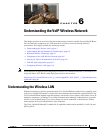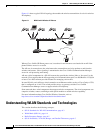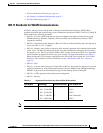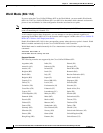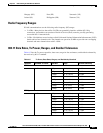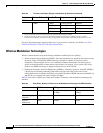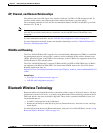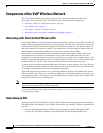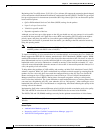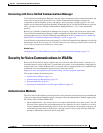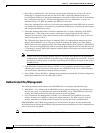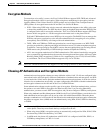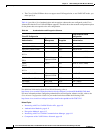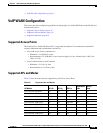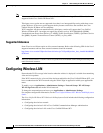
6-9
Cisco Unified IP Phone 8961, 9951, and 9971 Administration Guide for Cisco Unified Communications Manager 8.5 (SIP)
OL-20861-01
Chapter 6 Understanding the VoIP Wireless Network
Components of the VoIP Wireless Network
• Traffic Specification (TSpec)—Calculation of call limits and WLAN load balancing. The TSpec
value of each voice stream allows the system to allocate bandwidth to voice devices on a first-come,
first-served basis. For more information, see
“Voice QoS in a Wireless Network” section on
page 6-9.
The Cisco Unified IP Phone associates with the AP with the highest RSSI and lowest channel usage
values (QBSS) that have matching SSID and encryption types. To ensure that voice traffic is handled
properly, you must configure the correct QoS in the AP.
Related Topics
• Security for Voice Communications in WLANs, page 6-11
• VoIP WLAN Configuration, page 6-15
Voice QoS in a Wireless Network
Voice traffic on the Wireless LAN, like data traffic, is susceptible to delay, jitter, and packet loss. These
issues do not impact the data end user, but have serious implications for a voice call. To ensure that voice
traffic receives timely and reliable treatment with low delay and low jitter, you must use Quality of
Service (QoS), and use separate virtual LANs (VLANs) for voice and data. By isolating the voice traffic
onto a separate VLAN, you can use QoS to provide priority treatment for voice packets when traveling
across the network. Also, use a separate VLAN for data traffic, not the default native VLAN which is
typically used for all network devices.
You need the following VLANs on the network switches and the APs that support voice connections on
the WLAN:
• Voice VLAN—Voice traffic to and from the wireless IP phone
• Native VLAN—Data traffic to and from other wireless devices
Assign separate SSIDs to the voice and to the data VLANs. If you configure a separate management
VLAN in the WLAN, do not associate an SSID with the management VLAN.
By separating the phones into a voice VLAN and marking voice packets with higher QoS, you can ensure
that voice traffic gets priority treatment over data traffic resulting in lower packet delay and fewer lost
packets.
Unlike wired networks with dedicated bandwidths, wireless LANs consider traffic direction when
implementing QoS. Traffic is classified as upstream or downstream from the point of view of the AP as
shown in Figure 6-2.
Figure 6-2 Voice Traffic in a Wireless Network
206564
Downstream
Upstream
Downstream
Upstream
Network
Downstream QoS only
Bi-Directional QoS
IP



